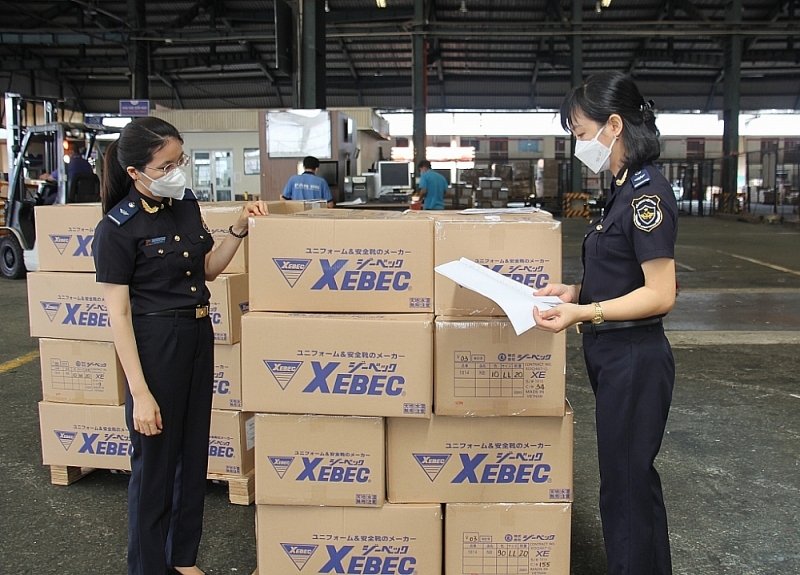 |
| Ho Chi Minh City’s export goods will increase in 2022. Photo: T.H |
Supply chain development
Tran Phu Lu, Deputy Director of ITPC said Vietnam’s economic recovery is expected to continue in the last month of 2022, supported by strong economic fundamentals, flexible monetary policy and faster-than-expected recovery in manufacturing, services and domestic consumption.
Notably, Ho Chi Minh City was recorded as a bright spot in the import and export of goods, especially exports. Accordingly, the total export turnover of goods by city enterprises through Ho Chi Minh City port, including crude oil, in the 10 months of 2022 reached nearly 36 million USD, up 10.1% over the same period in 2021.
Sharing about Vietnam’s export potential, Alex Tatsis, Chief Economic Officer, U.S. Consulate General in Ho Chi Minh City, said that Vietnam is the 10th largest trading partner of the U.S. globally and an important node in the supply chain of essential goods to the U.S. economy.
U.S. supply chain links with Vietnam are not one-way: Vietnam imports computer chips, hardwoods, cotton, and animal feed from the United States to use as raw materials for producing semiconductors, furniture, apparel and domestic seafood. Two-way trade helps Vietnam develop its domestic economy and export to global markets.
That is why the United States is also investing to help Vietnam strengthen its role in the global supply chain over the long term. Specifically, the United States enhances trade facilitation and the competitiveness of the private sector in Vietnam, especially among small and medium-sized enterprises. For example, through USAID’s Small and Medium Enterprises Connectivity Project, Vietnam’s small and medium-sized enterprises (SMEs) improve their production capacity, access financial resources, and realize digital transformation. This helps businesses better participate in the global supply chain for the mutual benefit of the two countries.
“Over the years, Vietnam has been one of the biggest beneficiaries of the supply chain shift away from China. But this shift has put pressure on Vietnam’s important infrastructure system and customs operations. To overcome this problem, the USAID Trade Facilitation Project is working with the General Department of Customs to adjust border clearance procedures and reduce congestion at major border gates, including Cat Lai port, the hub largest container shipping in Vietnam.”- Alex Tatsis emphasized.
Export business restructuring
To be suitable for export activities in the new situation, experts say that export enterprises need to be restructured. Dr Tu Minh Thien, an economic expert, said that restructuring export enterprises to adapt to the changes of new conditions for small and medium enterprises is an important issue in the current context.
According to Dr Tu Minh Thien, to restructure export enterprises, enterprises should pay attention to issues such as: Developing business strategies for each specific product and each target market; selecting market segments and distribution channels suitable to the product and size of the business; focusing on understanding the tastes, trends and characteristics of the market through international seminars, international fairs and exhibitions.
At the same time, increasing products in niche markets and approaching new markets. Invest in the development of organic or organic product lines that are friendly to the environment and human health; promote professional branding and development
Besides restructuring, attracting businesses to expand investment boost exports of Vietnamese enterprises. Impressed with the speed of Vietnam’s economic recovery, Mizushima Kozo, Chairman of the Japan Business Association in Ho Chi Minh City (JCCH), said that compared to other Southeast Asian countries, Vietnam’s economic recovery speed is extremely impressive. 63% of Japanese enterprises said they would continue investing in expansion in the next 1-2 years. This shows that investors have great expectations for Vietnam’s economic growth.
Similarly, Agustaviano Sofjan, Consul General of Indonesia in Ho Chi Minh City, said that despite the Covid-19 pandemic, Vietnam remains an attractive destination for many international investors thanks to its strategic location and policies to maintain economic growth.
Recently, at the 4th meeting of the Bilateral Cooperation Committee in July 2022, co-chaired by Indonesian Foreign Minister Retno Marsudi and Vietnamese Foreign Minister Bui Thanh Son, the two sides agreed that the new target for bilateral trade is 15 billion USD by 2028. This reflects optimism, and the two countries can raise the value of bilateral trade more strongly.
Matsumoto Nobuyuki, Chief Representative of the Japan Trade Promotion Organization in Ho Chi Minh City, shared that many Japanese companies said they want to expand their business in 2023. Therefore, many Japanese companies are interested in Vietnam about economic growth and the country’s future and want to invest in Vietnam. Furthermore, although Japanese companies want to focus on labour-intensive industries, they are also very interested in high-value-added sectors such as automobiles, electrical appliances, and the like.
Although it is forecasted that the difficulties of the world economy and global trade will last until early 2023, Vietnam’s export growth will depend on the development of the Russia-Ukraine military conflict, the restraint situation. In addition, inflation, epidemic prevention and control measures of major countries, and economic situation in large-scale import markets, but this is also a new opportunity for Vietnamese export enterprises to rise, continued to maintain the growth of commodity exports.
